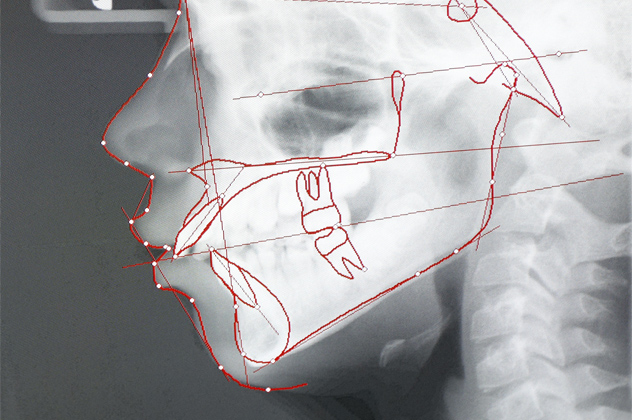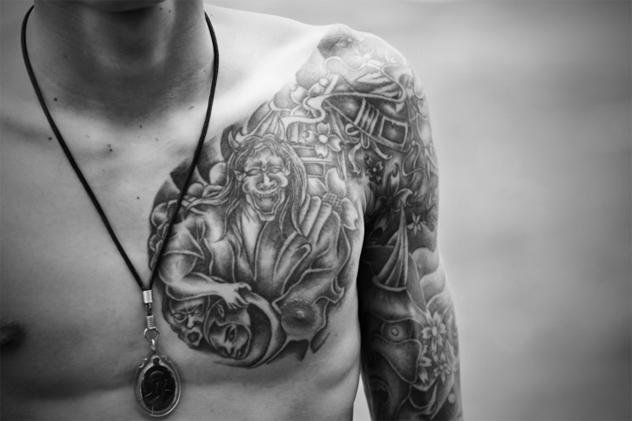10The Criminal Man
Cesare Lombroso was an Italian physician and early criminologist who lived in the 19th century. He was a huge supporter of the idea that people were just born to be criminals, and those people had certain physical and emotional traits that made them very clearly predetermined to be on the wrong side of the law. According to Lombroso, the criminal man could be identified by some specific traits that he determined by studying both living criminals and the bodies of those who had been executed. He said that the criminal man was something of an evolutionary throwback and would resemble a Neanderthal more than he would look like a normal, upstanding citizen. He also said that men who were destined to become criminals were born with an unhealthy appetite for violence and orgies, and often had tattoos that revealed their primal traits (more on that in a minute). The criminal man (and woman) was said to be identified by extra fingers and toes, protruding lips, bad teeth, abnormalities in the ears and nose, and even extra nipples. Lombroso also had an explanation for previously law-abiding citizens who suddenly did something terrible: He said that everyone was at risk of reverting back to their primal, ancestral mindset, and those criminals that do so should be punished more severely than lifelong criminals. After all, lifelong criminals couldn’t help the way they were, but punishment would bring others back to the right side of the law.
9The Criminal Woman
Lombroso also had a go at understanding the criminal woman. He said that while men were more likely to commit violent crimes, women were more likely to commit crimes of a sexual nature. The most common female criminal was the prostitute, he said, and women (who were already lower on the evolutionary ladder than men) who became criminals could often be identified by their narrow foreheads, receding hairlines, obesity, and small heads. He also cited left-handedness as one of the telltale signs of criminal tendencies in women, along with prehensile toes. Their personality was quite different from a responsible woman as well. While most good, decent women were preoccupied with being mothers, caring for their families, and not instigating sex whatsoever, the criminal woman packed her time with sex, alcohol, and orgies. She was also self-centered, self-absorbed, and lazy. He also said that women were less likely to be criminals than men, but prostitutes were still a pretty widespread phenomenon in all societies.
8Homicidal Monomania
In the early 1800s, psychologists found themselves struggling to explain why some people killed other people with no apparent reason for their actions. They dubbed the phenomenon “homicidal monomania” and used the term to explain killings with no understandable motivations. While even they weren’t too clear on how their idea worked, the disease was first described as lesions that developed on a person’s willpower and made them unable to keep themselves from killing. It was thought that these lesions made the killer view his victim as some kind of threat, and it was first used at the trial of a woman who had murdered her neighbor’s child. Also known as homicidal insanity and moral epilepsy, the theory continued to be very vaguely defined throughout the 19th century. This allowed it to be used as an explanation and defense in a variety of cases, and it often shows up in the literature of the time. Characters in works by Poe and Balzac describe thoughts that take root in their minds and become obsessions. They can’t explain why they’re obsessed with these things, but those obsessions grow and grow until they can’t control them anymore.
7Craniometry And Anthropometry
Early criminologists were obsessed with finding a biological root to criminal behavior. Like Lombroso, many others believed that those who committed criminal acts were physically less evolved than good, upstanding citizens, and they also believed that you could tell that by a person’s physical attributes. Anthropometry was the science of compiling measurements of the human body and included everything from a person’s height to the length of a person’s fingers. Similarly, craniometry is the taking of measurements from a person’s skull. When the theories were being developed, hundreds and hundreds of people were measured by criminologists and physicians, and those measurements were compiled to create a profile of the criminal. Supposedly, traits like wide, sloping foreheads—characteristics that were thought to be a throwback to early man and the Neanderthal—were touted as common among the criminal element. Not long after the theory was developed, it became commonplace for oppressors to cite craniometry measurements as justifications for their actions, turning the whole thing rather weirdly on its head. The British used supposed measurements of Irish skulls as reasoning for the atrocities visited upon them, while France was using it to show that women had smaller brains and were less evolved than men. The whole idea survived well into the middle of the 20th century, when Nazi scientists used similar measurements to support their claims that those racial groups they were persecuting were more closely related to animals than their ideal human.
6The Juke Family And Inherited Criminal Tendencies
In the 1870s, one New York family seemed to provide exactly what scientists wanted—cold, hard proof of genetic criminalism. According to sociologist Richard Dugdale, the so-called Juke family (Dugdale used a fake name for his family) was living, breathing proof that criminal tendencies were hereditary. The study first exposed six family members using four different names, all of whom were in jail for one crime or another. Doctors and law enforcement in the area confirmed that the family went way, way back and that they’d always been pretty shady. This was chalked up to the fact that they were said to marry outside of their family rather infrequently, and their lineage was traced back to a man named Max whose two sons married two sisters, and whose daughter Ada became known by the less-than-flattering pseudonym “Margaret, the mother of criminals.” The study released by Dugdale goes on to describe the ensuing generations of the family as drunkards, thieves, murderers, and degenerates of all kinds, along with lots and lots (and lots) of harlots and illegitimate children. A few decades later, the story of the family was seized upon to support the bizarre, dark cause of eugenics (which we’ve talked about here). Supporters of the movement pointed to the family who had supposedly spawned a massive amount of degenerates that included 50 prostitutes, 60 repeat thieves, and 40 women who had spread venereal diseases to hundreds of others.Supposedly the 1,258 members of the family that were alive in 1915 were costing the country what would, in today’s money, come to about $35 million a year in support. The only problem was, it wasn’t exactly true. When a grave site was uncovered in Ulster County in 2001, it renewed interest in the century-old case study. When researchers started digging, they found that the Juke family wasn’t just one family but a compilation of a number of different families, whose descendants included a New York State governor and other high-ranking members of society’s upper echelons. The case of the Juke family had been paraded before the public as fact-based criminology and science, while in reality it was another weird, disturbing push for forced sterilization and American eugenics.
5Body Types Prone To Criminal Activity
The idea of judging a person’s likelihood to commit criminal acts based on their appearance isn’t something that’s just out of textbooks from the early days of criminology. In the 1940s, a psychologist named William Sheldon created a basis for determining a person’s personality based on their body type—and that included whether or not they were likely to commit a crime. The idea behind morphology is this: When a baby is conceived, it has three different but equal skins. Whichever skin develops to be the strongest determines what kind of figure and body type the person has, which in turn determines basic characteristics about their personality. Ectomorphy refers to a person who develops from the outermost layer of skin and becomes long-limbed and fragile, and in turn develops an introverted personality and an overall frailty. Endomorphy refers to a person who develops from the innermost skin, which is associated with the digestive tract, resulting in a soft, overweight body and a lazy but pleasant personality. And mesomorphy develops from the middle skin and results in a person who is muscular, outgoing, and pretty hardcore. In order to determine just how body type and personality correlated, Sheldon enlisted the help of 200 subjects from the Hayden Goodwill Inn, a social service agency. Based on the body types of his subjects and their records of criminal activity, delinquency, and other social issues, he determined that mesomorphy—the muscular, fit build—was the most likely to lead to a criminal lifestyle. A follow-up study done 30 years later supported this idea, but it also found that looking at a person’s body type turned out to have no bearing on whether or not they were going to be a criminal; it meant that criminals might have a tendency to be muscular, but muscular people didn’t tend to be criminals. The findings pretty much put an end to that line of scientific research.
4Demonology
Demonology is in many ways the precursor to modern criminology, and it answers some of the basic questions that criminologists have struggled with since the establishment of the field. At the heart of many criminology theories lies the question of nature versus nurture, the idea that a person is either born a criminal or has the free will to choose whether or not to commit a crime. Demonology very firmly establishes that answer by pinning the criminal element on something beyond our realm of understanding. Crime results from demonic interference, and evil doesn’t come from the person—it comes from the devil. It’s an idea that’s pretty ancient, and different cultures had different ideas on how to deal with someone who was clearly possessed into criminal activity by a demon. The ancient Celts believed that sacrificing the person who had committed the crime would appease the gods who were angered by it, and the future would be revealed to them in the criminal’s death throes and/or entrails (if there were any left). Once Christianity took over, it became much more about a person’s ability to resist the pleasures that were associated with committing a crime, although it was very much acknowledged that some people were taken over completely by a demon and unable to control their actions. This tied demonology and criminology together pretty soundly, wrapping up exorcisms, free will, spells, therapies, and the supernatural together all in one little idiosyncratic package.
3How Tattoos Define The Criminal
It’s only fairly recently that tattooing has become a more accepted practice in the Western world, even though it’s been an integral part of many, many cultures for hundreds of years. According to our old friend Cesare Lombroso and his article “The Savage Art of Tattooing,” the practice is one that’s closely associated with the criminal element. He cited the number of criminals he had interviewed who had been tattooed, and came to the conclusion that tattoos, in themselves, were a part of the bestial side of man’s nature. He said that in order to undergo the procedure you had to have a higher tolerance of pain than the respectable person, as well as be willing to go through it for what he saw as no other reason than vanity. He cited a wide variety of tattoos and their meanings, from a horse’s head to represent animals the person has killed to dancing girls, headless women, chains and anchors, and hearts pierced by arrows to symbolize women hurt, abandoned, or abused. Lombroso said that it all adds up to proof that tattoos tell a criminal history and knowing how to read them means that you know how to read a dark life story. He also cited the use of gang tattoos for recognition and as badges of honor, and said that the sheer number of tattoos that many criminals have is nothing short of proof of their insensitivity and inability to feel pain. According to Lombroso, the fact that tattooing has been used in a number of different cultures he deemed less advanced was the final proof that, in his words, “Tattooing is, in fact, one of the essential characteristics of primitive man, and of men who still live in the savage state.” Support for the theory came from a weird place—turn-of-the-century architect Adolf Loos, who loathed the excessive ornamentation that he saw everywhere in society. He likened the extra decoration—tattoos as well as clothing styles—to being associated with the vanity of the criminal element. He even went so far as to say that any person with tattoos who died out of prison was just dodging the proverbial bullet.
2The Thermic Law Of Crime And Delinquency
In the beginning of the 19th century, researchers were looking into the idea that a person’s likelihood to commit a certain type of crime was directly linked to the weather—and research seemed to show that it was a legitimate theory. It was so legitimate, in fact, that criminologists were still looking into it in the 1980s, when it was only then largely debunked. The original theory stated that violent crimes were more likely to occur in warm climates or during the hottest months of the year, while crimes against property, like break-ins and car theft, were more likely to be committed in colder weather. Early criminologists who first researched the idea put forth that it was one of the largest factors in determining what types of crimes would be committed. Later researchers disagreed that it was a major factor, but still weighed in on the side of temperature and climate being one of many factors. One of the supposedly most telling studies was one that was done on assault cases in New York City between 1891 and 1897. A look at 40,000 different cases led to the conclusion that assaults and riots were more likely to happen in the hot summer months, when people’s blood was literally boiling. Later, it was found that there were other social factors that could explain away the various criminal acts, and the idea that it had something to do with the weather fell by the wayside.
1Freud’s Theory Of The Id And Nonexistence
Freud’s work never comes without a certain degree of controversy, and his thoughts on criminal behavior are no exception. Freud believed that we’re all pre-programmed with some basic desires, and it’s these desires that have kept us alive as a species. That includes the Id, the part of our personalities that we’re born with. The Id controls our desire for pleasure and immediate gratification, and it’s the Id that gets angry when we don’t get what we want. Freud also had a few specific things to say about the idea of the Id and the criminal nature. The first was that the Id was our more bestial side, and there was a part of us that wanted little more than to return to the state we existed in before we were civilized, rational, and bound by the constraints of society. Because the Id is only concerned with the self, it’s the part of a criminal’s mind that controls them. Freud also compared criminal tendencies to hysteria, and thought that they were two sides to the same coin. The only difference was that in someone suffering from hysteria, they don’t know the reason for their suffering. In the case of the criminal, he said, the criminal himself knows the cause, but he’s keeping it hidden from the rest of the world. These schools of thought influenced a number of different criminologists who came after him and were convinced that there was some hidden motive that the criminal mind could reveal, but just chose not to.
+Bowlby’s Maternal Deprivation Theory
According to psychoanalyst John Bowlby, one of the main reasons that people ended up turning to a life of crime was because of the lack of an intimate relationship with their mother. Citing the importance of imprinting that had been confirmed in another study using ducklings, Bowlby went on to explain his very Freud-inspired theory by stating that the first five years of a child’s development were crucial, and the bond established with a mother (biological or otherwise permanent) would determine how capable they were of feeling affection and concern for others, and whether or not they would develop criminal tendencies. His conclusions were mostly drawn from a study called the “44 Thieves” in which he interviewed adolescents who were attending regular sessions at a guidance clinic. It was found that more than half of the teens who were getting counseling for early criminal acts (like shoplifting) had spent much of their childhood separated from their mothers. On the other hand, his control group, who suffered from emotional problems but hadn’t committed any crimes yet, hadn’t suffered the same separation. Even though the study has had numerous others built upon its findings, critics point out some major flaws in the study. Bowlby got his data from interviewing his subjects, and other researchers have pointed out that they’re not exactly the most non-biased sources of data. He also absolutely neglected to factor in any other variables like family income and education, making the whole thing a bit unscientific. Read More: Twitter

























